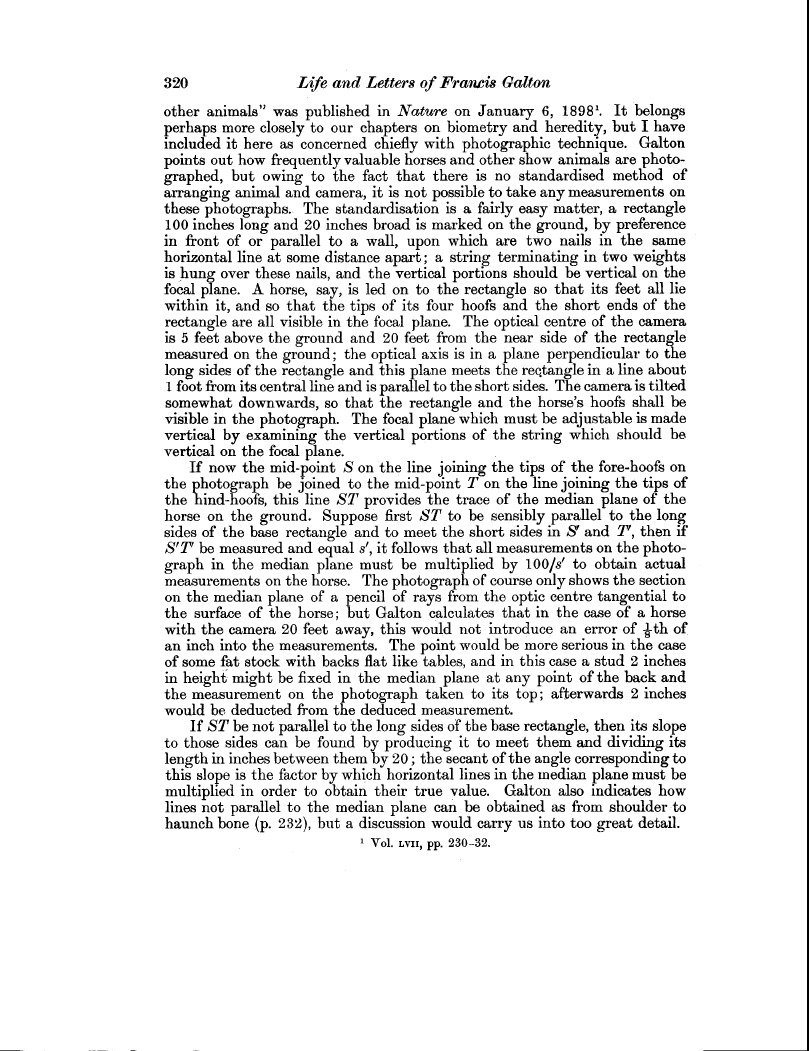320 Life and Letters of Francis Galton
other animals" was published in Nature on January 6, 1898'. It belongs perhaps more closely to our chapters on biometry and heredity, but I have included it here as concerned chiefly with photographic technique. Galton points out how frequently valuable horses and other show animals are photographed, but owing to the fact that there is no standardised method of arranging animal and camera, it is not possible to take any measurements on these photographs. The standardisation is a fairly easy matter, a rectangle 100 inches long and 20 inches broad is marked on the ground, by preference in front of or parallel to a wall, upon which are two nails in the same horizontal line at some distance apart ; a string terminating in two weights is hung over these nails, and the vertical portions should be vertical on the focal plane. A horse, say, is led on to the rectangle so that its feet all lie within it, and so that the tips of its four hoofs and the short ends of the rectangle are all visible in the focal plane. The optical centre of the camera is 5 feet above the ground and 20 feet from the near side of the rectangle measured on the ground ; the optical axis is in a plane perpendicular to the long sides of the rectangle and this plane meets the rectangle in a line about 1 foot from its central line and is parallel to the short sides. The camera is tilted somewhat downwards, so that the rectangle and the horse's hoofs shall be visible in the photograph. The focal plane which must be adjustable is made vertical by examining the vertical portions of the string which should be vertical on the focal plane.
If now the mid-point S on the line joining the tips of the fore-hoofs on the photograph be joined to the mid-point T on the line joining the tips of the hind-hoofs, this line ST provides the trace of the median plane of the horse on the ground. Suppose first ST to be sensibly parallel to the long sides of the base rectangle and to meet the short sides in S' and T, then if S'' be measured and equal s', it follows that all measurements on the photograph in the median plane must be multiplied by 100/s' to obtain actual measurements on the horse. The photograph of course only shows the section on the median plane of a pencil of rays from the optic centre tangential to the surface of the horse ; but Galton calculates that in the case of a horse with the camera 20 feet away, this would not introduce an error of s th of an inch into the measurements. The point would be more serious in the case of some fat stock with backs flat like tables, and in this case a stud 2 inches in height- might be fixed in the median plane at any point of the back and the measurement on the photograph taken to its top ; afterwards 2 inches would be deducted from the deduced measurement.
If ST be not parallel to the long sides of the base rectangle, then its slope to those sides can be found by producing it to meet them and dividing its length in inches between them by 20; the secant of the angle corresponding to this slope is the factor by which horizontal lines in the median plane must be multiplied in order to obtain their true value. Galton also indicates how lines not parallel to the median plane can be obtained as from shoulder to haunch bone (p. 232), but a discussion would carry us into too great detail.
1 VOL LVII, pp. 230-32.

